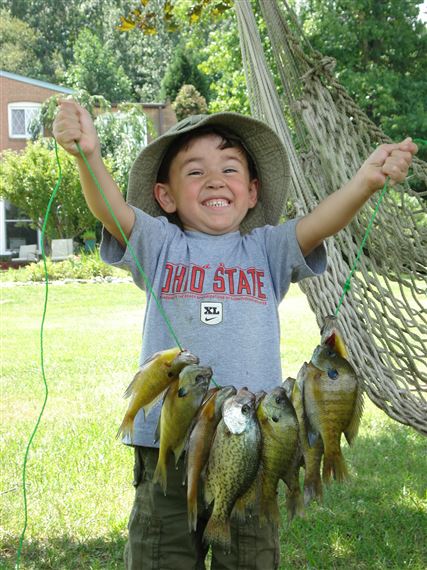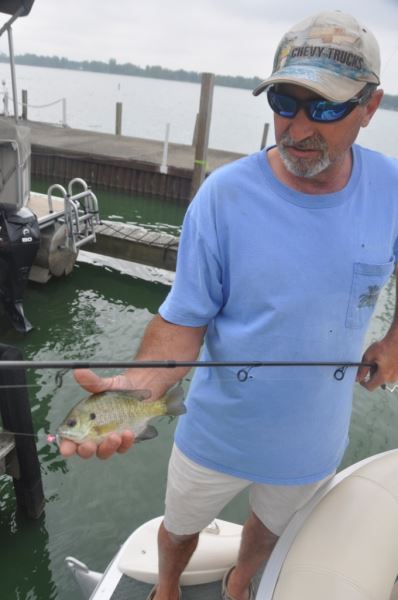
Chances are good that the first fish you ever caught was a sunfish—and more likely than not a bluegill to boot, one of the most widely distributed of the popular “bream” band of panfish, as they are known in the South.
.JPG_600.jpg) Bluegills have saved many a fishing trip for anglers whose primary species wasn’t willing to cooperate. The avid, accessible biters are a “Plan B” or “backup” target for many anglers who cut their eyeteeth fooling the feisty fish but moved on to larger game once they figured they had mastered the hook and line sport. The panfish are often considered “patsies” by anglers who know how easy sunfish are to catch in the spring, and how small their relative size can be compared to bass, walleye, trout and even their crappie cousins. Few fishermen direct their attention toward catching bluegills and other sunfish, especially in the summer months when even these panfish can present a challenge, especially the larger specimens.
Bluegills have saved many a fishing trip for anglers whose primary species wasn’t willing to cooperate. The avid, accessible biters are a “Plan B” or “backup” target for many anglers who cut their eyeteeth fooling the feisty fish but moved on to larger game once they figured they had mastered the hook and line sport. The panfish are often considered “patsies” by anglers who know how easy sunfish are to catch in the spring, and how small their relative size can be compared to bass, walleye, trout and even their crappie cousins. Few fishermen direct their attention toward catching bluegills and other sunfish, especially in the summer months when even these panfish can present a challenge, especially the larger specimens.
Any time during the open water season, if I am entertaining kids or non-anglers aboard my boat, and they express an interest in catching a fish (and what kid doesn’t?), I will count on bluegills to make the effect a success. Beginning anglers of any age don’t care what they catch, as long as the bobber “bobs” and they get to hook and land something with fins. The bonus of a spirited battle that a chunky bluegill brings to the game makes the sunfish even more fun for first-timers to target.
.JPG_600.jpg) But again, size doesn’t matter when introducing anglers to fishing, when it’s all about quantity to keep their attention, give them confidence, and teach them the basics of baiting hooks, casting, presenting baits, setting the hook, fighting and landing the fish, unhooking and releasing—or keeping the fish for a meal. And many are the anglers who prefer the sweet meat of bluegill over all others.
But again, size doesn’t matter when introducing anglers to fishing, when it’s all about quantity to keep their attention, give them confidence, and teach them the basics of baiting hooks, casting, presenting baits, setting the hook, fighting and landing the fish, unhooking and releasing—or keeping the fish for a meal. And many are the anglers who prefer the sweet meat of bluegill over all others.
To tangle with sunfish, and your deck or pontoon boat is at a dock, you may not even have to loose the lines to get into the action. Ditto launch ramp, courtesy and designated fishing docks. Some of the best panfishing can often be found right under the boats, or around the dock pilings that provide shade, food and cover for bluegills and their finned kin. Dropping a worm-baited hook suspended a few feet under a bobber near any structure will reveal the presence of any sunfish in the area. Depending on water clarity and temperature, you may have to set the bobber to hold your bait deeper until you find the level where the bluegills are holding—or where the bruiser bream are concentrated. Often the small sunfish are the shallowest, and the larger specimens holding in the deeper water below or adjacent to the shallow biters.
 That’s true of wherever you find bluegills, which this time of year may be anywhere from the edges of weedbeds and lily pads to along sheer drop-offs. On our home waters, a Midwestern flood control reservoir, during the heat of the summer months I head to one of several steep, shale walls that tower above the water and plunge nearly straight down to a depth of 15 feet or more. The bluegills (and crappie and bass) hold tight to the contours of ragged, crumbling slate wall, and bait presented more than a couple feet from the sheaths of stacked shale may be ignored by the fickle fish. More often than not, the bite comes lightning-fast after a well-aimed cast plops the bobber and bait in range of the sunfish that dart out from under the cover of the slate to grab the meal and return to the shadows. Turning their broad sides to the pressure, the bluegill will swim circles to fight against the hook and line, with a power out of proportion to their size. An ultralight spincast or spinning reel spooled with 4- to 8-pound test line, a few size 10 light wire hooks, quarter-size bobbers and a tub of redworms can make for a fun mid-summer afternoon for anglers of all levels of experience.
That’s true of wherever you find bluegills, which this time of year may be anywhere from the edges of weedbeds and lily pads to along sheer drop-offs. On our home waters, a Midwestern flood control reservoir, during the heat of the summer months I head to one of several steep, shale walls that tower above the water and plunge nearly straight down to a depth of 15 feet or more. The bluegills (and crappie and bass) hold tight to the contours of ragged, crumbling slate wall, and bait presented more than a couple feet from the sheaths of stacked shale may be ignored by the fickle fish. More often than not, the bite comes lightning-fast after a well-aimed cast plops the bobber and bait in range of the sunfish that dart out from under the cover of the slate to grab the meal and return to the shadows. Turning their broad sides to the pressure, the bluegill will swim circles to fight against the hook and line, with a power out of proportion to their size. An ultralight spincast or spinning reel spooled with 4- to 8-pound test line, a few size 10 light wire hooks, quarter-size bobbers and a tub of redworms can make for a fun mid-summer afternoon for anglers of all levels of experience.
It’s a cat and mouse game I’ve played against the same banks for half a century and still enjoy sharing with others, fishermen of all ages who never fail to squeal with delight at the fury of the first few bites and the resulting battle with a pugnacious panfish.
[Tackle—Bluegill] Bluegills are a “best bet” fish for beginning anglers to target.
[Tackle—Bait] Anything from worms, pieces of night crawlers, larval baits and crickets make great summer baits for fooling bluegills and other sunfish.
[Tackle--Dock Fishing] You don’t have to go far from the dock—or even leave it—to find active bluegills feeding around the pilings and in the shadows of the boat hulls.
[Tackle—13753] Where you catch one bluegill you can usually count on finding more, as this lad learned—with the bonus catch of a keeper crappie.